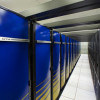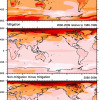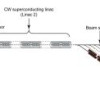News Archive
New Consortium to Tackle Challenge of Adapting Scientific Applications to Hybrid Multicore Systems
PORTLAND, Oregon—While hybrid multicore technologies will be a critical component in future high-end computing systems, most of today's scientific applications will require a significant re-engineering effort to take advantage of the resources provided by these systems. To address this challenge, three U.S. Department of Energy national laboratories, including the Berkeley Lab, and two leading universities have formed the Hybrid Multicore Consortium, or HMC, and held their first meeting at SC09. Read More »
Lawrence Berkeley National Laboratory Selects IBM Technology to Power Cloud Computing Research
Armonk, NY and Berkeley, CA — IBM and the Lawrence Berkeley National Laboratory (Berkeley Lab) announced today that an IBM System x iDataPlex server will run the Lab's program to explore how cloud computing can be used to advance scientific discovery. Read More »
Berkeley Lab Staff to Present Papers, Participate in Tutorials, Panels, BoFs, More at SC09
When SC09 convenes Nov. 14 in Portland, LBNL researchers will participate in two tutorials, present four technical papers, join in one panel discussion, give two Masterworks talks and lead two Birds-of-a-Feather sessions. Tutorials Hank Childs of Lawrence Berkeley National Laboratory and Sean Ahern of Oak Ridge National Laboratory will present “VisIt - Visualization and Analysis for Very Large Data Sets,” a tutorial on VisIt, an open source visualization and analysis tool designed for… Read More »
NERSC Continues Tradition of Cosmic Microwave Background Data Analysis with the Planck Cluster
More than 95 percent of our universe is made up of mysteriously "dark" materials—approximately 22 percent of it is comprised of invisible dark matter, while another 73 percent is posited to be dark energy, the force that is accelerating universal expansion. Read More »
B-ISICLES (Berkeley Ice Sheet Initiative for Climate at Extreme Scales) Project to Improve Accuracy of Ice Sheet Models
One of the most-cited examples of global climate change is retreating ice sheets in Antarctica and Greenland. But the detail of how fast they are melting is a mystery that may be solved with a new generation of computer simulations.
Read More »
NERSC Uses Stimulus Funds to Overcome Software Challenges for Scientific Computing
A "multi-core" revolution is occurring in computer chip technology. No longer able to sustain the previous growth period where processor speed was continually increasing, chip manufacturers are instead producing multi-core architectures that pack increasing numbers of cores onto the chip. In the arena of high performance scientific computing, this revolution is forcing programmers to rethink the basic models of algorithm development, as well as parallel programming from both the language and parallel decomposition process. Read More »
Berkeley Lab Researchers Prepare U.S. Climate Community for 100-Gigabit Data Transfers
As researchers around the world tackle the issue of global climate change, they are both generating and sharing increasingly large amounts of data. This increased collaboration helps climate scientists better understand what is happening and evaluate the effectiveness of possible mitigations. Read More »
It's Not Too Late
The threat of global warming can still be greatly diminished if nations cut emissions of heat-trapping greenhouse gases by 70 percent this century, according to a study led by scientists at the National Center for Atmospheric Research (NCAR). While global temperatures would rise, the most dangerous potential aspects of climate change, including massive losses of Arctic sea ice and permafrost and significant sea level rise, could be partially avoided. Read More »
Lasers without mirrors, designed by supercomputer
Sometimes it takes a big machine to understand the tiniest details.
That’s the case with free electron lasers (FELs). The powerful X-rays they generate can probe matter directly at the level of atomic interactions and chemical-bond formation, letting scientists observe such phenomena as chemical reactions in trace elements, electric charges in photosynthesis and the structure of microscopic machines. FELs have the potential to address a host of research challenges in physics, chemistry and material and biological sciences. Read More »
DOE to Explore Scientific Cloud Computing at Argonne, Lawrence Berkeley National Laboratories
ARGONNE, Ill., and BERKELEY, Calif. (Oct. 14, 2009) – Cloud computing is gaining traction in the commercial world, but can such an approach also meet the computing and data storage demands of the nation's scientific community? A new program funded by the American Recovery and Reinvestment Act through the U.S. Department of Energy (DOE) will examine cloud computing as a cost-effective and energy-efficient computing paradigm for scientists to accelerate discoveries in a variety of disciplines, including analysis of scientific data sets in biology, climate change and physics. Read More »







 Instagram
Instagram YouTube
YouTube



